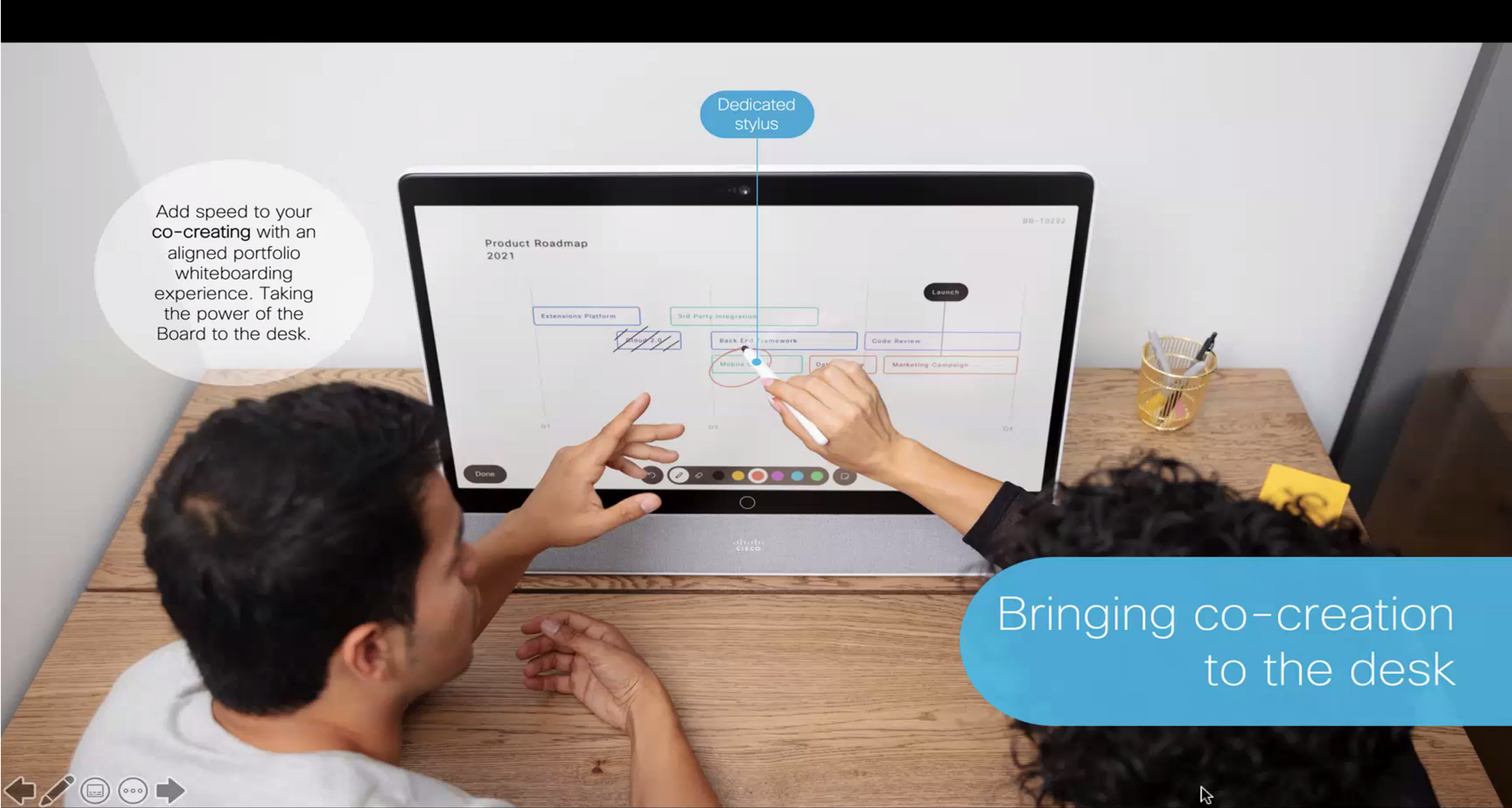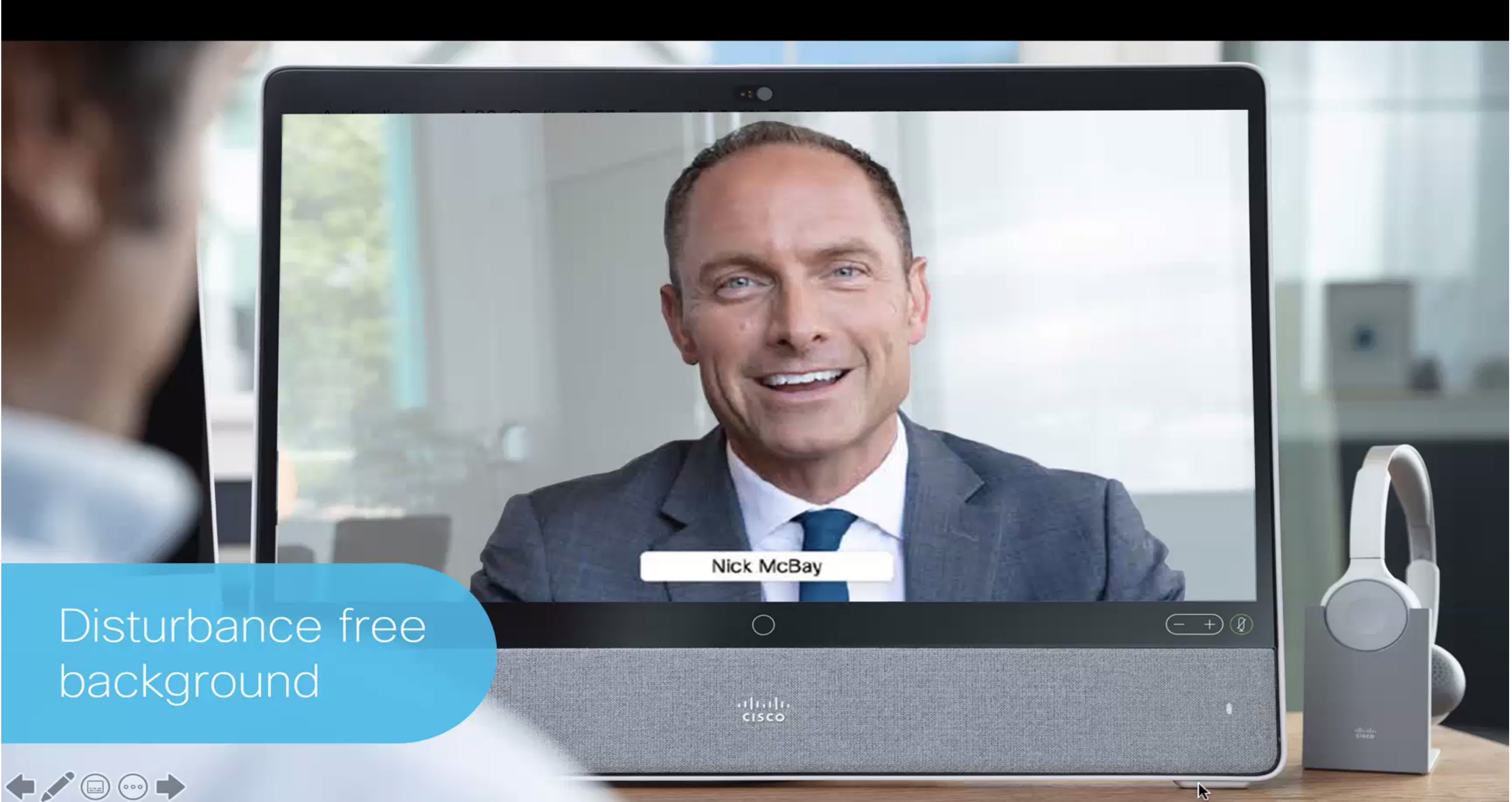Cisco collaboration made
several significant announcements last week. Buried within are two new video room solutions: the Room Panorama and Desk Pro. Both are intriguing, but I intend to focus on the Desk Pro in this post.
Room Panorama
First, a quick look at the Room Panorama. With this solution, Cisco takes its concept of immersive video to a new level. It can effectively split a conference table (and room) between the here (the physical room) and there (the far end virtual table). Its goal is to remove distance as a barrier to natural, cross-table interactions.
The Room Panorama comes with all the recent cognitive collaboration features that Cisco has announced. This includes centralized admin from Webex Control Hub for unified management, analytics, security, and diagnostics.
The Room Panorama replaces the IX5000, introduced in 2015. I think it’s noteworthy that the IX5000 lasted nearly five years on the line card and will continue to be supported for years to come. Five-year lifespans in hardware are becoming rare, but Cisco manages this with high-end specifications and ongoing software updates.
The Desk Pro
The Cisco Desk Pro is more intriguing to me because it’s a new kind of device. I haven’t seen one yet, and the name isn’t particularly exciting. The name doesn’t even make sense because its wall mount option eliminates the need for a desk. Though I haven’t come up with a better name — it’s hard because it doesn’t fit any known profile.
It’s a highly versatile all-in-one. That’s not particularly useful either because the industry has been making all-in-ones for years. Though most don’t include a display, and only a few include the necessary software and processor to host a meeting. This device really is an all-in-one. Cisco describes it as an “Instant Office,” which is reasonably accurate, but where’s the chair?!
At first glance, the Desk Pro appears to be a next-generation DX80 (introduced in 2015). This isn’t the case as Cisco sees enough differentiation to maintain both products. The DX80 is a dedicated video endpoint with a 23” HD touch-display and remains a viable HD desktop meeting solution, running for about $2,100.
The Desk Pro is bigger with a 27” 4K touch display. At that size, it can provide a desktop immersive experience. The size also allows the camera to be high enough to avoid those up-the-nose shots, common with video cameras on laptops and videophones. It’s also big enough to share with a colleague or two. It’s suitable on a desktop or side-table, or in a smaller-than-huddle shared room — what Cisco terms a Jump Space (AKA phone booth). The Desk Pro also has high-end A/V specifications. Specifically, eight beamforming microphones, four speakers, and a 4K camera (with built-in physical privacy cover).
Like Cisco’s other room products, the Desk Pro has proximity pairing and NVIDIA GPUs. Proximity detection means a user with Webex on their smartphone can instantly pair with the Desk Pro and use it for ad hoc or scheduled meetings. Even external guests can pair their smartphone (and Webex profile) with the Desk Pro to use the Webex profile on the phone.
The NVIDIA processors enable on-device machine learning capabilities. For example, the auto-framing capability of the camera works in concert with the beamforming microphone array to adjust the profile based on the speaker(s) location. Another AI feature, associated with Cisco’s push for cognitive collaboration, is background manipulation. This also uses the onboard GPUs. Unfortunately, most software-based virtual greenscreens can’t keep up with participant movements. Webex Assistant also leverages the local processing for improved natural language processing.
Cisco expects street prices for the Desk Pro to be below $5,000. That may seem high when compared against other personal systems, but the Desk Pro does more. Specifically, the Desk Pro can be a phone, speaker saucer, video system, PC monitor, eboard, USB A/V devices (camera, microphone, and speaker), and in some cases, a desktop workstation. Here is a breakdown of each:
- Video solution – The Desk Pro shines as a personal video system. The camera supports auto-tracking, auto-framing, and background manipulation (background blur or virtual greenscreen).
- Phone – With Webex Calling, the Desk Pro can be used as a simple telephone, though the user may want to add a headset or handset. The Desk Pro supports USB or Bluetooth accessories, and Cisco’s headsets can also be managed from Webex Hub.
- Saucer phone – Use the Desktop Pro’s beamforming microphones, noise control, and speakers for audio conferencing.
- Webex board – The Desk Pro is a mini Webex Board. It comes with a stylus (or just use your finger). The board supports co-ideation with other participants but can also be used for creative solo-storming without a meeting.
- Display – The 27” 4K touch-display can also be used as a monitor for a desktop, laptop, or smartphone. Both video and touch-redirect are supported over a single USB-C cable.
- Camera and speakers – There’s no need to purchase separate cameras and speakers for a PC. The USB pass-thru feature allows a PC to use these devices with a single USB C connection.
- Workstation – The Desk Pro contains a Chromium browser that can run HTML 5 applications. In other words, the Desk Pro can be a desktop workstation for web-enabled workflows.
Inside the Desk Pro is Cisco’s new RoomOS. This new operating system is working its way into most of Cisco’s room systems. All RoomOS devices can be centrally managed from the Webex Hub, even across locations. RoomOS standardizes Cisco’s room devices, which varied across devices and deployment types.
RoomOS also supports digital signage capabilities. Via Webex Hub administrators can leverage unused room screens enterprise-wide for announcements and updates. Digital signage is normally associated with office environments, but it also helps teleworkers stay connected to their office.
The Instant Office concept is particularly relevant for teleworkers. The single device can be used for work apps, collaboration, and communication that includes video, audio, and drawings. The blurred background or virtual greenscreen offers privacy that can otherwise inhibit teleworkers from using video.
The Desk Pro’s design also positions it for public and vertical solutions. For example, administrators can disable its buttons (kiosk-mode for public environments). A steel faceplate option can replace the textile cover, which can be more appropriate for certain locations.
I consider the Desk Pro one of the better re-imagined phones. Though the internals have changed, the phone’s form factor and UI haven’t changed since push-button dialing was introduced in the 1960s. Most of my calls today are video, most of my conversations are chat, and most of my apps are web-based. The Desk Pro offers a fresh approach that will upgrade my office, home office, or anywhere else.
Dave Michels is a Contributing Editor and Principal Analyst at TalkingPointz.











